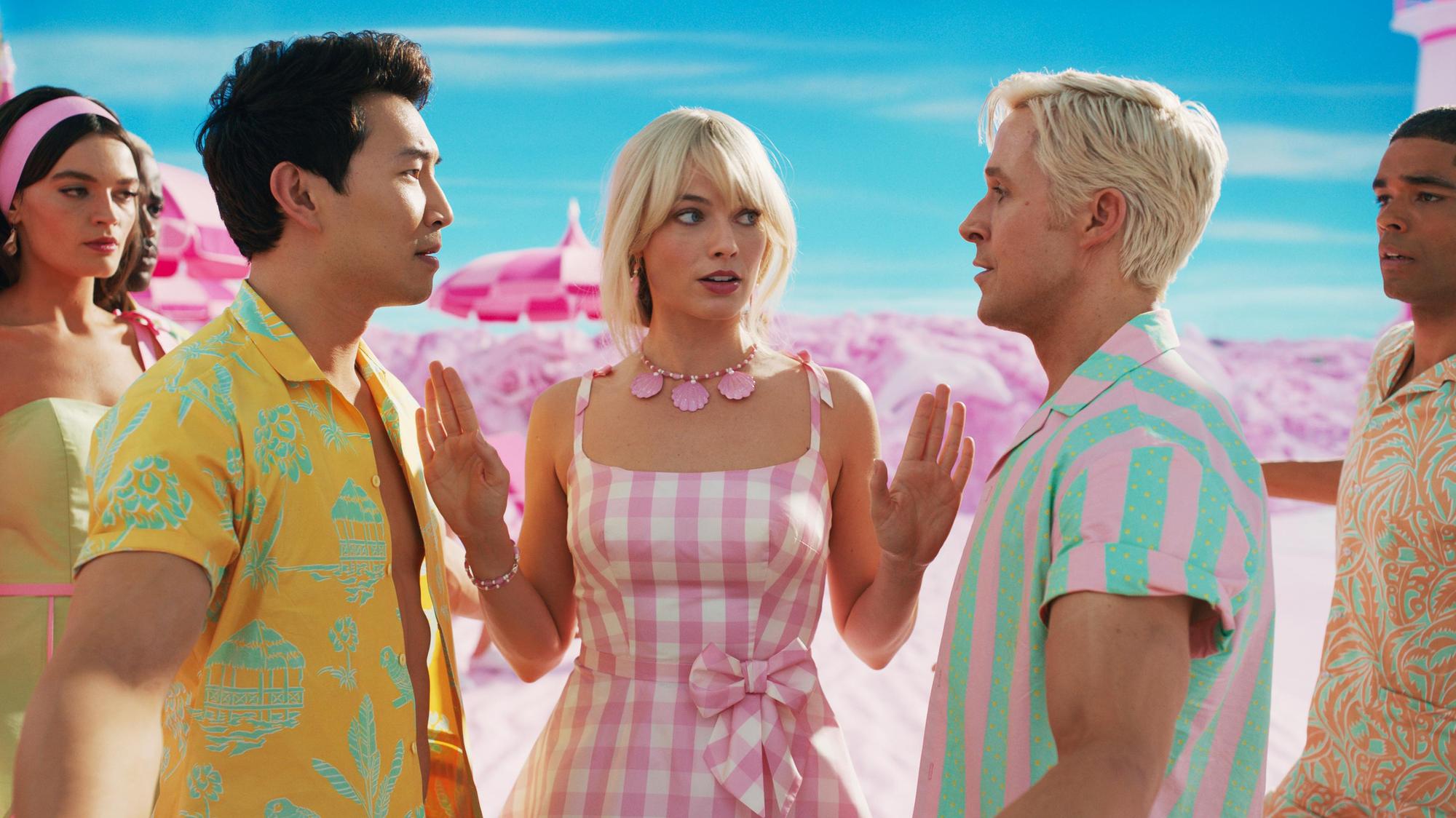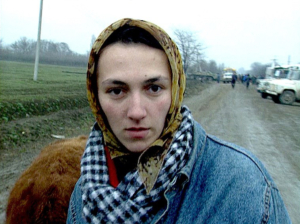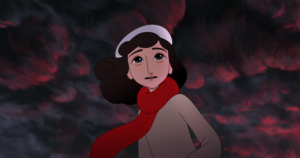In 1949, philosopher Simone de Beauvoir famously wrote, ‘One is not born, but rather becomes, a woman.’[1]Simone de Beauvoir, The Second Sex, trans. Howard Madison Parshley, Vintage, London, 1997 [1949], p. 295. The original French phrase is ‘On ne naît pas femme: on le devient.’ Parshley’s translation dates from the first English-language edition of the book in 1953, and has been criticised for failing to capture the nuances of Beauvoir’s philosophical language. In 2009, a new translation by Constance Borde and Sheila Malovany-Chevallier sought to restore Beauvoir’s voice; in this version, the phrase reads, ‘One is not born, but rather becomes, woman.’ See Constance Borde & Sheila Malovany-Chevallier, ‘Translating the Second Sex’, Books & Ideas, 17 November 2011, <https://booksandideas.net/Translating-the-Second-Sex>, accessed 7 November 2023. Ten years later, Barbie was born – or, rather, moulded.[2]See Marie-Claire Chappet, ‘The Real History of Barbie’, Harper’s Bazaar, 13 July 2023, <https://www.harpersbazaar.com/uk/culture/entertainment/a44129282/barbie-real-history/>, accessed 7 November 2023. Over the past sixty-four years, as generations of children have grown up playing with Barbie dolls, commentators have pointed out the complex and often problematic ways in which Barbies, in turn, mould their owners.[3]See, for example, Brittney McNamara, ‘Study Shows Barbie Dolls Negatively Impact Young Girls’ Body Image’, Teen Vogue, 12 September 2016, <https://www.teenvogue.com/story/barbie-body-image-study>, accessed 17 November 2023.
Pop culture moulds us, too, as Greta Gerwig acknowledges in the witty opening sequence of her 2023 film Barbie, which meticulously parodies the corresponding ‘Dawn of Man’ sequence in 2001: A Space Odyssey (Stanley Kubrick, 1968). A colossal, ponytailed Margot Robbie looms over a rocky wilderness: an alien glamourpuss wearing the same black-and-white-striped swimsuit in which Barbie was first sold in 1959. Winking knowingly over her cat-eye sunglasses, she incites awe-struck little girls to smash their baby dolls.
Just as 2001’s mysterious black monolith spurs prehistoric primates to grasp the evolutionary power of technology, so Gerwig playfully suggests that Barbie’s adult body and heavy-lidded gaze reconfigured the relationship between girls and their toys, provoking them to see the doll not as their imagined baby, but as their own ideal future self. ‘Some day I’m gonna be exactly like you,’ crooned the very first Barbie TV commercial, which aired during the phenomenally popular Mickey Mouse Club show. ‘Till then […] I’ll make believe that I am you.’[4]‘1959 First EVER Barbie Commercial’, YouTube, 21 May 2007, <https://www.youtube.com/watch?v=h8-avPUxyno>, accessed 15 November 2023.
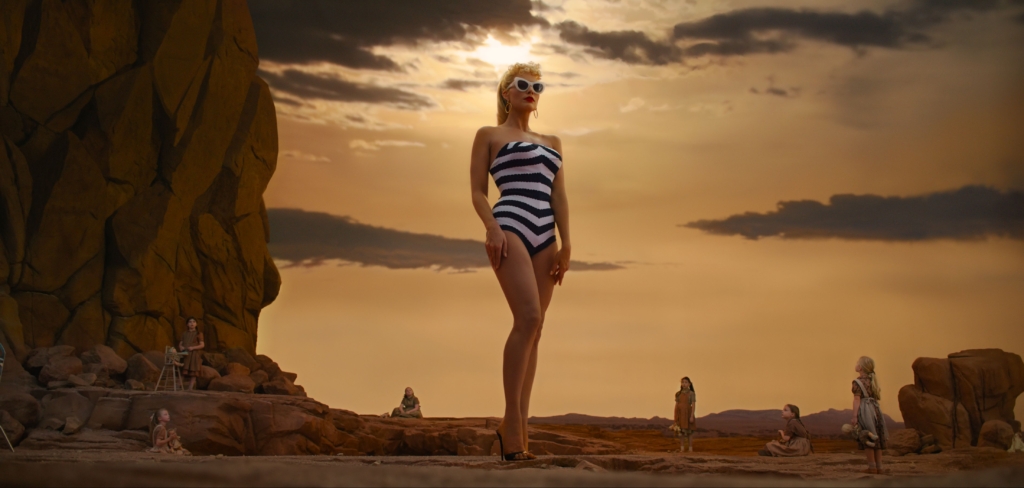
Gerwig is a successful indie actor, screenwriter and Oscar-nominated filmmaker, whose films Lady Bird (2017) and Little Women (2019) cemented her feminist credentials.[5]See, for example, Lara Williams, ‘Youth in Revolt: Is Lady Bird the First Truly Feminist Teen Movie?’, The Guardian, 20 February 2018, <https://www.theguardian.com/film/filmblog/2018/feb/20/is-lady-bird-a-feminist-teen-movie-greta-gerwig-saoirse-ronan>; and Jessica Bennett, ‘This Is Little Women for a New Era’, The New York Times, updated 8 January 2020, <https://www.nytimes.com/2020/01/02/books/little-women-feminism-2019-movie.html>, accessed 16 November 2023. But when her Barbie project was announced, sceptical observers doubted she could smuggle any social critique into a movie that exists because toy corporation Mattel sought to ‘leverage its intellectual property at the multiplex’.[6]Alex Barasch, ‘After Barbie, Mattel Is Raiding Its Entire Toybox’, The New Yorker, 2 July 2023, <https://www.newyorker.com/magazine/2023/07/10/after-barbie-mattel-is-raiding-its-entire-toybox>, accessed 16 November 2023. ‘I think to myself, every time: Why did they let us do this?’ Gerwig told New York Times Magazine journalist Willa Paskin,[7]Greta Gerwig, quoted in Willa Paskin, ‘Greta Gerwig’s Barbie Dream Job’, The New York Times Magazine, 11 July 2023, <https://www.nytimes.com/2023/07/11/magazine/greta-gerwig-barbie.html>, accessed 15 November 2023. who concluded, cynically, that Mattel was exploiting Gerwig’s reputation in order to ‘return a retirement-age hunk of plastic to the zeitgeist’.[8]Paskin, ibid.
Yet Gerwig’s Barbie is plastic in the word’s other sense: malleable, adaptable, in a constant process of becoming. It’s a film about corporate cultural manipulation that also rejoices in the imaginative manipulation of play. The film is affectionate about the nostalgic history of an iconic toy, but skewers restrictive gender roles for men as well as women. Its plot also highlights how capitalism assimilates feminist critique.
‘Things can be both/and,’ Gerwig insisted. ‘I’m doing the thing and subverting the thing.’[9]Gerwig, quoted in ibid. But is she, really?
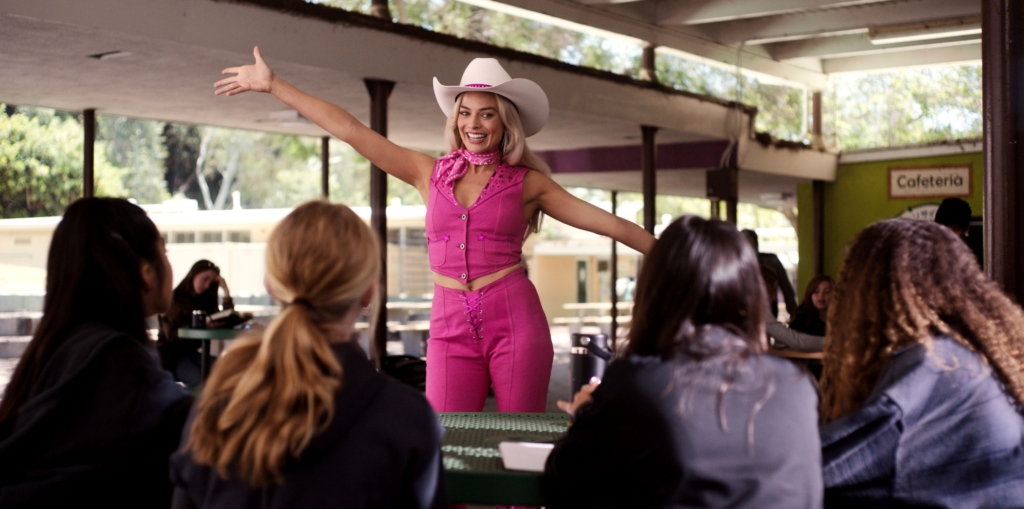
Following the pink-brick road
Barbie[10]Although a recurring joke in the film is that the proper names of all Barbies and Kens are simply ‘Barbie’ or ‘Ken’, the dolls are also individualised through references to their jobs or character traits; hence Barbie’s main Barbie and Ken protagonists are also, inconsistently, diegetically referred to as ‘Stereotypical Barbie’ and ‘Beach Ken’ respectively. The former descriptor is explained in the film as merely denoting ‘the Barbie you think of when someone says, “Think of a Barbie”’, but Robbie has stated in interview that the name was chosen in full knowledge of its ‘negative connotations’. See Margot Robbie, quoted in Nicole Sperling, ‘Margot Robbie and Ryan Gosling on Barbie and Kenergy’, The New York Times, 13 July 2023, <https://www.nytimes.com/2023/07/13/movies/margot-robbie-ryan-gosling-barbie.html>, accessed 27 November 2023. (Margot Robbie) wakes in her Dreamhouse – a neon-pink plastic palace that looks exactly like the playset. Because it has no walls, she waves ‘Hi, Barbie!’ to her neighbours. Then she steps into a fake shower on moulded tippy-toe feet, pretends to eat breakfast and dresses herself in a pink gingham frock before strolling out into space to float directly into her pink convertible car – all just as a child manipulates a doll while playing. It’s a delightful introduction to Barbie Land: the fantasy realm where all Barbies dwell, and that children are meant to imagine while interacting with Mattel’s products.
Gerwig’s Barbie is plastic in the word’s other sense: malleable, adaptable, in a constant process of becoming. It’s a film about corporate cultural manipulation that also rejoices in the imaginative manipulation of play.
The most common feminist criticism of Barbie is that she trains young children to internalise patriarchal gender roles,[11]See, for example, Gemma Witcomb, ‘Barbie at 60: Instrument of Female Oppression or Positive Influence?’, The Conversation, 8 March 2019, <https://theconversation.com/barbie-at-60-instrument-of-female-oppression-or-positive-influence-113069>, accessed 15 November 2023. while the impossibly buxom-yet-slender doll herself promotes a homogeneous and exclusionary beauty ideal.[12]See, for example, Gina Jones, ‘What’s Still Missing from the Barbie Collection’, Bustle, 2 February 2016, <https://www.bustle.com/articles/138279-what-the-new-barbie-collection-is-still-missing>, accessed 15 November 2023. Yet this does not square with either the way Mattel has assiduously updated its products to reflect changing social norms[13]See Chappet, op. cit. or the chaotic and sometimes violent logic of children’s play.[14]A 2006 study in Developmental Psychology found older children and boys were especially likely to engage Barbies in ‘anger play’ that subverts the dolls’ stereotypical social perfection by punishing or mutilating them. Cited in Karen E Dill-Shackleford, ‘Barbie Evokes Suffering in Girls, Scorn in Teens and Finally Gets Reshaped’, OUPblog, 19 February 2016, <https://blog.oup.com/2016/02/barbie-body-image-social-psychology/>, accessed 15 November 2023.
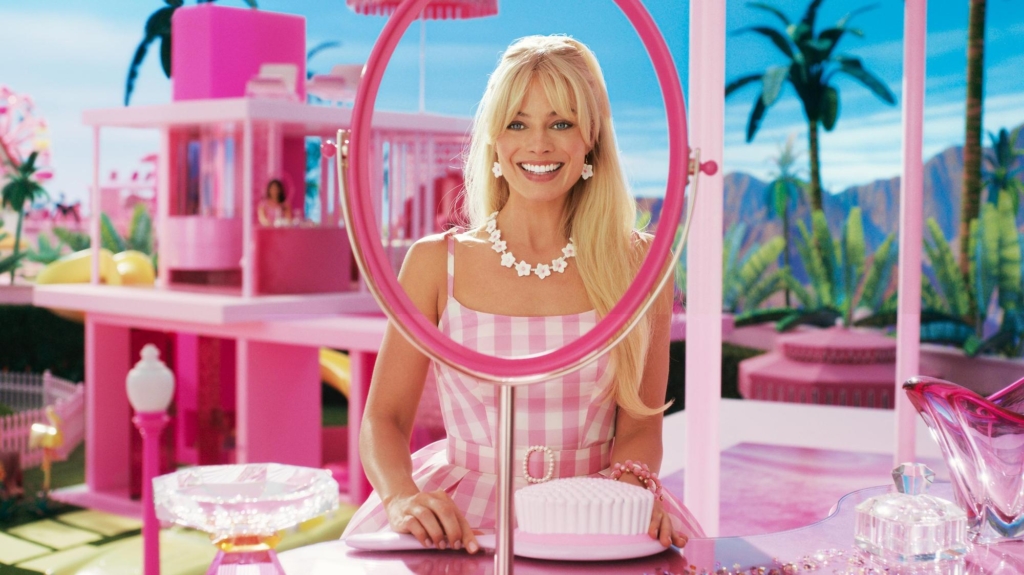
Gerwig’s film, however, accommodates both. Unlike the Toy Story movies, where toys only ‘come to life’ when not being played with, Barbie Land symbolises a bond between each doll and its individual owner. ‘We create them and then they create us and we recreate them and they recreate us,’ Gerwig has explained. ‘We’re in constant conversation with inanimate objects.’[15]Gerwig, quoted in Paskin, op. cit.
The existential panic that begins to grip Barbie therefore reflects the disillusionment of her original owner, Gloria (America Ferrera), a Mattel product designer experiencing a midlife crisis. When Barbie wonders aloud, ‘Do you guys ever think about dying?’, Gloria’s angst begins to destroy Barbie Land’s magic – symbolised by the comic body horror of Barbie’s arched feet falling flat.
Upon consulting a zany mystic known as Weird Barbie (Kate McKinnon), whose hacked-short hair, felt-pen graffiti make-up and default leg-split pose are all signs she has been ‘played with […] too hard’, Barbie learns that she can restore the play-bond by following the pink-brick road to the Real World – a nod to the yellow-brick road of The Wizard of Oz (Victor Fleming, 1939). Effectively, Barbie must resolve her human owner’s angst.
All the Barbies believe that liberal feminism[16]Liberal feminism is the strand of feminism that works towards gender equality within existing systems, fighting for women’s ability to be and do whatever they want in the world as it is; in this, it differs from more structurally oriented approaches such as radical and socialist feminism. See Jone Johnson Lewis, ‘Liberal Feminism’, ThoughtCo, updated 4 October 2019, <https://www.thoughtco.com/liberal-feminism-3529177>, accessed 16 November 2023. must run the Real World, just as it ostensibly does in Barbie Land. How else could a unanimously elected President Barbie (Issa Rae) govern a benign Barbiarchy that also includes Nobel Prize–winning Journalist Barbie (Ritu Arya), Diplomat Barbie (Nicola Coughlan), Judge Barbie (Ana Cruz Kayne), Lawyer Barbie (Sharon Rooney), Physicist Barbie (Emma Mackey), Writer Barbie (Alexandra Shipp) and more? In 2016, trans actress Hari Nef tweeted, ‘where is trans barbie’;[17]Hari Nef, Twitter post dated 29 January 2016, <https://twitter.com/harinef/status/692728705852973056>, accessed 16 November 2023, cited in Jones, op. cit. here, Nef herself is Doctor Barbie.
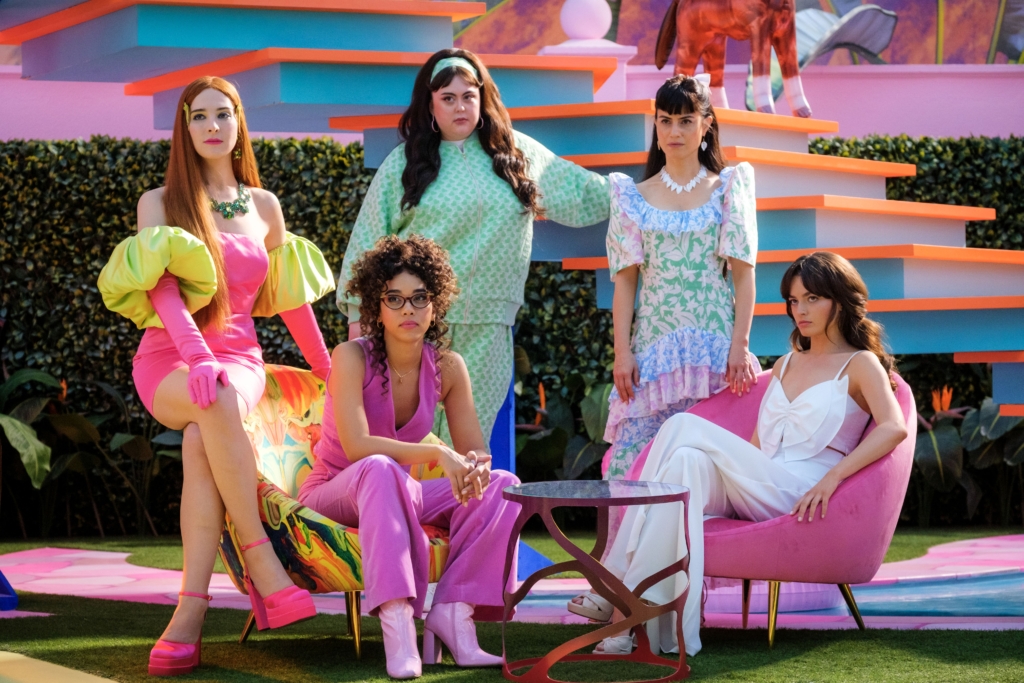
For others, however, Barbie Land is a dystopia. Ken (Ryan Gosling) is merely Barbie’s accessory, with no job other than ‘beach’. Ignored by Barbie, he can only assert himself by competing with other Kens for her attention; in a musical sequence at the film’s climax, he laments that he is ‘just Ken’ and wonders whether he is doomed to ‘live and die a life of blond fragility’. Ken’s predicament is touching – not just because of Gosling’s earnest performance, but also because Ken occupies an analogous role in Barbie Land to that of women under real-world patriarchy.
Meanwhile, Weird Barbie’s house – coded as ‘deviant’ by its strong resemblance to the Bates home from Psycho (Alfred Hitchcock, 1960) – represents Barbie Land’s repressed cultural memory. It’s an Island of Misfit Toys[18]The ‘Island of Misfit Toys’ was introduced in the 1964 Christmas TV special Rudolph the Red-Nosed Reindeer (Larry Roemer). Similarly, in the UK TV series The Raggy Dolls (1986–1994), a motley collection of toys ‘made imperfectly’ find a new community in a toy factory’s reject bin. for all the real Mattel products that pushed the play-bond in unseemly directions. Here dwell Tanner, the pooing dog; Teen Talk Barbie (Marisa Abela), who infamously says, ‘Math class is tough!’;[19]‘Company News: Mattel Says It Erred; Teen Talk Barbie Turns Silent on Math’, The New York Times, 21 October 1992, <https://www.nytimes.com/1992/10/21/business/company-news-mattel-says-it-erred-teen-talk-barbie-turns-silent-on-math.html>, accessed 16 November 2023. Growing Up Skipper (Hannah Khalique-Brown), Barbie’s pubescent little sister whose breasts enlarge when you pull her arm; and Barbie Video Girl (Mette Narrative), who has a TV screen embedded in her back.
Ken’s predicament is touching – not just because of Gosling’s earnest performance, but also because Ken occupies an analogous role in Barbie Land to that of women under real-world patriarchy.
Also living with Weird Barbie are the cancelled Kens. There’s the notoriously gay-coded Earring Magic Ken (Tom Stourton) and the fluffy-dog-toting Sugar Daddy Ken (Rob Brydon). Then there is Allan (Michael Cera), whom Mattel introduced in 1964 as ‘Ken’s “buddy”’– ‘All of Ken’s clothes fit him!’ – then discontinued two years later, ostensibly due to poor sales,[20]See Ethan Shanfeld, ‘Michael Cera Personally Emailed Greta Gerwig to Be Cast in Barbie, She Responded: “Let’s Get on a Zoom Right Now”’, Variety, 17 August 2023, <https://variety.com/2023/film/news/michael-cera-barbie-casting-greta-gerwig-email-1235699057/>, accessed 27 November 2023. though it’s also been suggested that the male dolls’ friendship was seen to undermine the Barbie-and-Ken heterosexual dyad.[21]See Tom Chapman, ‘Barbie: The Queer-coded Coming Out Story of Ken’s “Buddy” Allan, Explained’, Attitude, 19 July 2023, <https://www.attitude.co.uk/culture/film-tv/the-coming-out-story-of-the-barbie-movies-allan-440855/>, accessed 16 November 2023.
As Barbie and Ken learn when they travel to the Real World, Mattel’s constantly revised products seek to resolve all of life’s ‘weirdness’ through consumerism. While Barbie discovers humanity’s messy, imperfect beauty, Ken discovers patriarchy … and returns to remould Barbie Land as a male chauvinist paradise where all the Barbies passively serve and flatter the Kens – mirroring with disturbing accuracy the real-life grievances of ‘men’s rights activists’ and the ways they become radicalised against feminism.[22]See Lucy Nicholas, ‘Ken’s Rights? Our Research Shows Barbie Is Surprisingly Accurate on How “Men’s Rights Activists” Are Radicalised’, The Conversation, 25 July 2023, <https://theconversation.com/kens-rights-our-research-shows-barbie-is-surprisingly-accurate-on-how-mens-rights-activists-are-radicalised-210273>, accessed 25 July 2023.
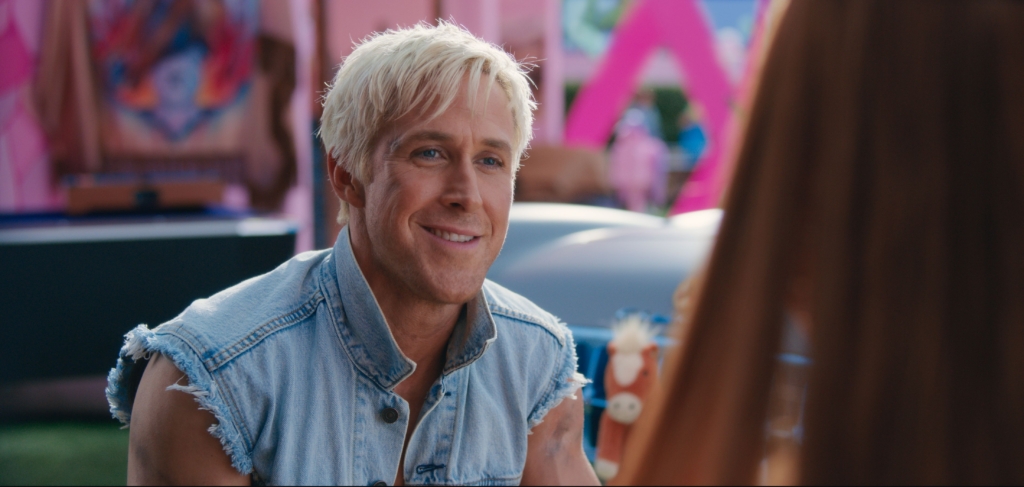
Becoming a woman
When Barbie follows her play-bond to a Los Angeles school, she’s devastated to learn that teenage Sasha (Ariana Greenblatt) not only refuses to claim her, but also repudiates everything Barbie Land represents, telling her, ‘You set the feminist movement back fifty years. You destroy girls’ innate sense of worth.’
Only when she glimpses Sasha’s mother, Gloria, does Barbie truly identify her old playmate. And when Sasha reluctantly accompanies Barbie and Gloria to Barbie Land, she’s puzzled and embarrassed by Gloria’s nostalgic delight at being there. However, Gloria’s weary rage at being a woman under patriarchy ultimately helps mother and daughter understand each other better – and helps the Barbies wrest back control of Barbie Land from the horse-obsessed, ‘brewski beer’–chugging Kens.
Barbie surprised commentators who had expected the film to show how girls like Sasha learn their femininity from Barbie; instead, older characters like Gloria teach Barbie what it means to be a woman. Body-image expert Zali Yager recounts looking around a cinema packed with excited ‘30- to 40-something mums’ watching Barbie: ‘It dawned on me. This was not a movie for children. This was a movie for us.’[23]Zali Yager, ‘What a Body Image Expert Really Thinks of the Barbie Movie’, Women’s Agenda, 21 July 2023, <https://womensagenda.com.au/latest/what-a-body-image-expert-really-thinks-of-the-barbie-movie/>, accessed 16 November 2023.
Echoing the ‘consciousness-raising’ sessions of the 1960s and 1970s[24]See Deirdre Mendoza, ‘My Mother Was a Feminist: A Call to Consciousness’, Ms., 15 November 2019, <https://msmagazine.com/2019/11/15/my-mother-was-a-feminist-a-call-to-consciousness/>, accessed 16 November 2023. in which women found feminism by sharing their experiences of everyday sexism and misogyny, Gloria voices the impossible burden that patriarchy forces women to carry:
You have to never get old, never be rude, never show off, never be selfish, never fall down, never fail, never show fear, never get out of line. It’s too hard! It’s too contradictory! And nobody gives you a medal or says thank you. And it turns out, in fact, that not only are you doing everything wrong, but also everything is your fault.
As Gloria detonates more entry-level-feminist truth bombs, she breaks the Kensplaining spell that turned the Barbies into submissive girlfriends. But this is not the only way in which Barbie attributes a sense of magic to the intergenerational transfer of wisdom. Disconsolate in the Real World, Barbie slumps at a bus stop alongside an old woman (played by 91-year-old costume designer Ann Roth). Having never known ageing, an awe-struck Barbie whispers, ‘You’re so beautiful,’ to which the woman smilingly replies, ‘I know it.’
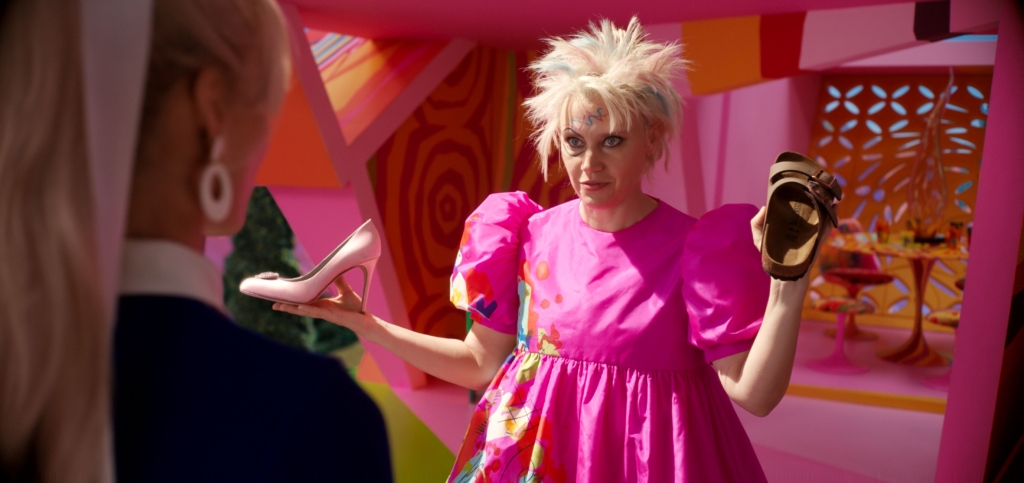
In Margery Williams’ 1922 children’s book The Velveteen Rabbit, a dilapidated but wise nursery ‘skin horse’ – the Weird Barbie of this story – explains to the eponymous stuffed rabbit how ‘growing shabby’ through a child’s persistent love renders a toy ‘Real’: ‘It doesn’t happen all at once. You become. It takes a long time […] Once you are Real you can’t be ugly, except to people who don’t understand.’[25]Margery Williams, The Velveteen Rabbit, Dover Publications, Mineola, NY, 2011 [1922], pp. 8, 9. Towards the end of the book, discarded and forgotten, the Velveteen Rabbit sheds a tear, summoning a fairy who cares for worn-out, discarded toys:
‘I take care of all the playthings that the children have loved […] I come and take them away with me and turn them into Real.’
‘Wasn’t I Real before?’ asked the little Rabbit.
‘You were Real to the Boy,’ the Fairy said, ‘because he loved you. Now you shall be Real to every one.’ [26]ibid., pp. 30–1.
Reaching Mattel’s headquarters, Barbie is briefly tempted by a promise from the clownish CEO (Will Ferrell) and his all-male executive board that all of her troubles will be erased if she gets ‘in the box’ – a giant replica of the cellophane-fronted boxes in which Barbie dolls are sold, which acts as an unsubtle metaphor for men’s efforts to control and limit women.[27]This lends a cleverly sinister air to the similar boxes that Barbie’s distributor, Warner Bros., installed in cinema foyers as a promotional gimmick; any cinema patron playfully photographed inside a Barbie box gets to metatextually announce that they, too, have been captured by the capitalist patriarchy.
Barbie is like a Barbie playset: it’s delightfully funny and witty, full of intricate moving parts; yet its subversiveness is artificial.
As plastic twist-ties magically emerge from the box to pin down her wrists, Barbie has second thoughts. She flees through the Mattel building, where, in a sunlit kitchen, she encounters the gentle ghost of her own inventor, Ruth Handler (Rhea Perlman). Gerwig underscores the sacredness of this fairy-godmother meeting by framing a close-up of Ruth’s hands passing Barbie a cup of tea, evoking the moment of connection between man and Creator represented in the Michelangelo fresco The Creation of Adam.
Barbie and Ruth later commune in a sequence whose dreamlike setting is clearly influenced by the British World War II–era fantasy-romance film A Matter of Life and Death (Michael Powell & Emeric Pressburger, 1946), in which an RAF pilot (David Niven) appeals his death before a celestial court. Having learned what it is to be a real woman, Barbie cannot return to being a doll; ‘I want to do the imagining; I don’t want to be the idea,’ she says. And just as Glinda (Billie Burke), the good witch in The Wizard of Oz, tells Dorothy (Judy Garland), ‘You’ve always had the power to go back to Kansas,’ Barbie is amazed to learn that she doesn’t need Ruth’s permission to be human: ‘It’s something that I just discover I am?’
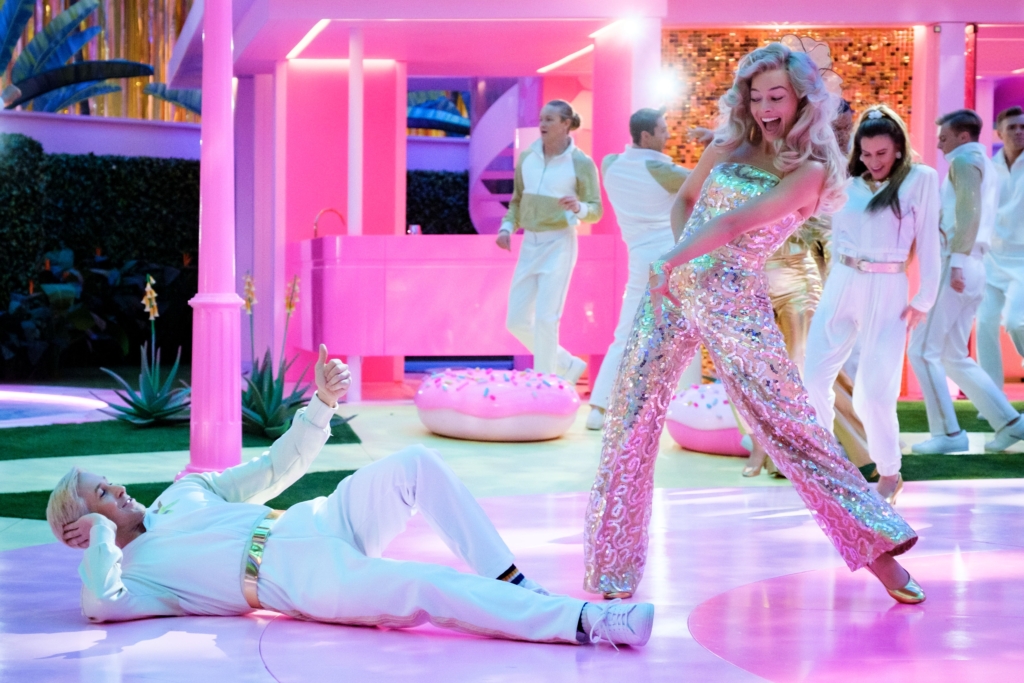
Barbie is like a Barbie playset: it’s delightfully funny and witty, full of intricate moving parts; yet its subversiveness is artificial. Although the film’s rhetoric is progressive – ‘We mothers stand still,’ Ruth says, ‘so that our daughters can look back to see how far they’ve come’ – the Barbies’ feminist awakening fails to motivate change to their society so it no longer dominates the Kens or ostracises the ‘weird’ Barbies. Instead, Barbie Land returns to its complacent status quo; Weird Barbie accepts responsibility for ‘sanitation’ (cleaning up after the other Barbies); and Ken learns he is ‘Kenough’ – a joke about personal growth that slaps down his recognisably feminist yearning with a banal cliché. Gerwig puts the Barbies ‘back in their box’ to be sold over and over.
Either the film’s subtlest critique or its most cynical shortcoming is the scene in which, after Ken has transformed Barbie’s Dreamhouse into his own ‘Mojo Dojo Casa House’, this product becomes a bestseller in the diegetic Real World. In our world, where Barbie is 2023’s top-grossing film worldwide,[28]‘2023 Worldwide Box Office’, Box Office Mojo, <https://www.boxofficemojo.com/year/world/>, accessed 16 November 2023. capitalism will always find a way to channel people’s identities and desires into consumer purchases. As the movie’s tagline threatens, ‘If you hate Barbie [… or] if you love Barbie, this movie is for you.’[29]See ‘Barbie | Main Trailer’, YouTube, 26 May 2023, <https://www.youtube.com/watch?v=pBk4NYhWNMM>, accessed 27 November 2023. Punctuation added.
Endnotes
| 1 | Simone de Beauvoir, The Second Sex, trans. Howard Madison Parshley, Vintage, London, 1997 [1949], p. 295. The original French phrase is ‘On ne naît pas femme: on le devient.’ Parshley’s translation dates from the first English-language edition of the book in 1953, and has been criticised for failing to capture the nuances of Beauvoir’s philosophical language. In 2009, a new translation by Constance Borde and Sheila Malovany-Chevallier sought to restore Beauvoir’s voice; in this version, the phrase reads, ‘One is not born, but rather becomes, woman.’ See Constance Borde & Sheila Malovany-Chevallier, ‘Translating the Second Sex’, Books & Ideas, 17 November 2011, <https://booksandideas.net/Translating-the-Second-Sex>, accessed 7 November 2023. |
|---|---|
| 2 | See Marie-Claire Chappet, ‘The Real History of Barbie’, Harper’s Bazaar, 13 July 2023, <https://www.harpersbazaar.com/uk/culture/entertainment/a44129282/barbie-real-history/>, accessed 7 November 2023. |
| 3 | See, for example, Brittney McNamara, ‘Study Shows Barbie Dolls Negatively Impact Young Girls’ Body Image’, Teen Vogue, 12 September 2016, <https://www.teenvogue.com/story/barbie-body-image-study>, accessed 17 November 2023. |
| 4 | ‘1959 First EVER Barbie Commercial’, YouTube, 21 May 2007, <https://www.youtube.com/watch?v=h8-avPUxyno>, accessed 15 November 2023. |
| 5 | See, for example, Lara Williams, ‘Youth in Revolt: Is Lady Bird the First Truly Feminist Teen Movie?’, The Guardian, 20 February 2018, <https://www.theguardian.com/film/filmblog/2018/feb/20/is-lady-bird-a-feminist-teen-movie-greta-gerwig-saoirse-ronan>; and Jessica Bennett, ‘This Is Little Women for a New Era’, The New York Times, updated 8 January 2020, <https://www.nytimes.com/2020/01/02/books/little-women-feminism-2019-movie.html>, accessed 16 November 2023. |
| 6 | Alex Barasch, ‘After Barbie, Mattel Is Raiding Its Entire Toybox’, The New Yorker, 2 July 2023, <https://www.newyorker.com/magazine/2023/07/10/after-barbie-mattel-is-raiding-its-entire-toybox>, accessed 16 November 2023. |
| 7 | Greta Gerwig, quoted in Willa Paskin, ‘Greta Gerwig’s Barbie Dream Job’, The New York Times Magazine, 11 July 2023, <https://www.nytimes.com/2023/07/11/magazine/greta-gerwig-barbie.html>, accessed 15 November 2023. |
| 8 | Paskin, ibid. |
| 9 | Gerwig, quoted in ibid. |
| 10 | Although a recurring joke in the film is that the proper names of all Barbies and Kens are simply ‘Barbie’ or ‘Ken’, the dolls are also individualised through references to their jobs or character traits; hence Barbie’s main Barbie and Ken protagonists are also, inconsistently, diegetically referred to as ‘Stereotypical Barbie’ and ‘Beach Ken’ respectively. The former descriptor is explained in the film as merely denoting ‘the Barbie you think of when someone says, “Think of a Barbie”’, but Robbie has stated in interview that the name was chosen in full knowledge of its ‘negative connotations’. See Margot Robbie, quoted in Nicole Sperling, ‘Margot Robbie and Ryan Gosling on Barbie and Kenergy’, The New York Times, 13 July 2023, <https://www.nytimes.com/2023/07/13/movies/margot-robbie-ryan-gosling-barbie.html>, accessed 27 November 2023. |
| 11 | See, for example, Gemma Witcomb, ‘Barbie at 60: Instrument of Female Oppression or Positive Influence?’, The Conversation, 8 March 2019, <https://theconversation.com/barbie-at-60-instrument-of-female-oppression-or-positive-influence-113069>, accessed 15 November 2023. |
| 12 | See, for example, Gina Jones, ‘What’s Still Missing from the Barbie Collection’, Bustle, 2 February 2016, <https://www.bustle.com/articles/138279-what-the-new-barbie-collection-is-still-missing>, accessed 15 November 2023. |
| 13 | See Chappet, op. cit. |
| 14 | A 2006 study in Developmental Psychology found older children and boys were especially likely to engage Barbies in ‘anger play’ that subverts the dolls’ stereotypical social perfection by punishing or mutilating them. Cited in Karen E Dill-Shackleford, ‘Barbie Evokes Suffering in Girls, Scorn in Teens and Finally Gets Reshaped’, OUPblog, 19 February 2016, <https://blog.oup.com/2016/02/barbie-body-image-social-psychology/>, accessed 15 November 2023. |
| 15 | Gerwig, quoted in Paskin, op. cit. |
| 16 | Liberal feminism is the strand of feminism that works towards gender equality within existing systems, fighting for women’s ability to be and do whatever they want in the world as it is; in this, it differs from more structurally oriented approaches such as radical and socialist feminism. See Jone Johnson Lewis, ‘Liberal Feminism’, ThoughtCo, updated 4 October 2019, <https://www.thoughtco.com/liberal-feminism-3529177>, accessed 16 November 2023. |
| 17 | Hari Nef, Twitter post dated 29 January 2016, <https://twitter.com/harinef/status/692728705852973056>, accessed 16 November 2023, cited in Jones, op. cit. |
| 18 | The ‘Island of Misfit Toys’ was introduced in the 1964 Christmas TV special Rudolph the Red-Nosed Reindeer (Larry Roemer). Similarly, in the UK TV series The Raggy Dolls (1986–1994), a motley collection of toys ‘made imperfectly’ find a new community in a toy factory’s reject bin. |
| 19 | ‘Company News: Mattel Says It Erred; Teen Talk Barbie Turns Silent on Math’, The New York Times, 21 October 1992, <https://www.nytimes.com/1992/10/21/business/company-news-mattel-says-it-erred-teen-talk-barbie-turns-silent-on-math.html>, accessed 16 November 2023. |
| 20 | See Ethan Shanfeld, ‘Michael Cera Personally Emailed Greta Gerwig to Be Cast in Barbie, She Responded: “Let’s Get on a Zoom Right Now”’, Variety, 17 August 2023, <https://variety.com/2023/film/news/michael-cera-barbie-casting-greta-gerwig-email-1235699057/>, accessed 27 November 2023. |
| 21 | See Tom Chapman, ‘Barbie: The Queer-coded Coming Out Story of Ken’s “Buddy” Allan, Explained’, Attitude, 19 July 2023, <https://www.attitude.co.uk/culture/film-tv/the-coming-out-story-of-the-barbie-movies-allan-440855/>, accessed 16 November 2023. |
| 22 | See Lucy Nicholas, ‘Ken’s Rights? Our Research Shows Barbie Is Surprisingly Accurate on How “Men’s Rights Activists” Are Radicalised’, The Conversation, 25 July 2023, <https://theconversation.com/kens-rights-our-research-shows-barbie-is-surprisingly-accurate-on-how-mens-rights-activists-are-radicalised-210273>, accessed 25 July 2023. |
| 23 | Zali Yager, ‘What a Body Image Expert Really Thinks of the Barbie Movie’, Women’s Agenda, 21 July 2023, <https://womensagenda.com.au/latest/what-a-body-image-expert-really-thinks-of-the-barbie-movie/>, accessed 16 November 2023. |
| 24 | See Deirdre Mendoza, ‘My Mother Was a Feminist: A Call to Consciousness’, Ms., 15 November 2019, <https://msmagazine.com/2019/11/15/my-mother-was-a-feminist-a-call-to-consciousness/>, accessed 16 November 2023. |
| 25 | Margery Williams, The Velveteen Rabbit, Dover Publications, Mineola, NY, 2011 [1922], pp. 8, 9. |
| 26 | ibid., pp. 30–1. |
| 27 | This lends a cleverly sinister air to the similar boxes that Barbie’s distributor, Warner Bros., installed in cinema foyers as a promotional gimmick; any cinema patron playfully photographed inside a Barbie box gets to metatextually announce that they, too, have been captured by the capitalist patriarchy. |
| 28 | ‘2023 Worldwide Box Office’, Box Office Mojo, <https://www.boxofficemojo.com/year/world/>, accessed 16 November 2023. |
| 29 | See ‘Barbie | Main Trailer’, YouTube, 26 May 2023, <https://www.youtube.com/watch?v=pBk4NYhWNMM>, accessed 27 November 2023. Punctuation added. |
